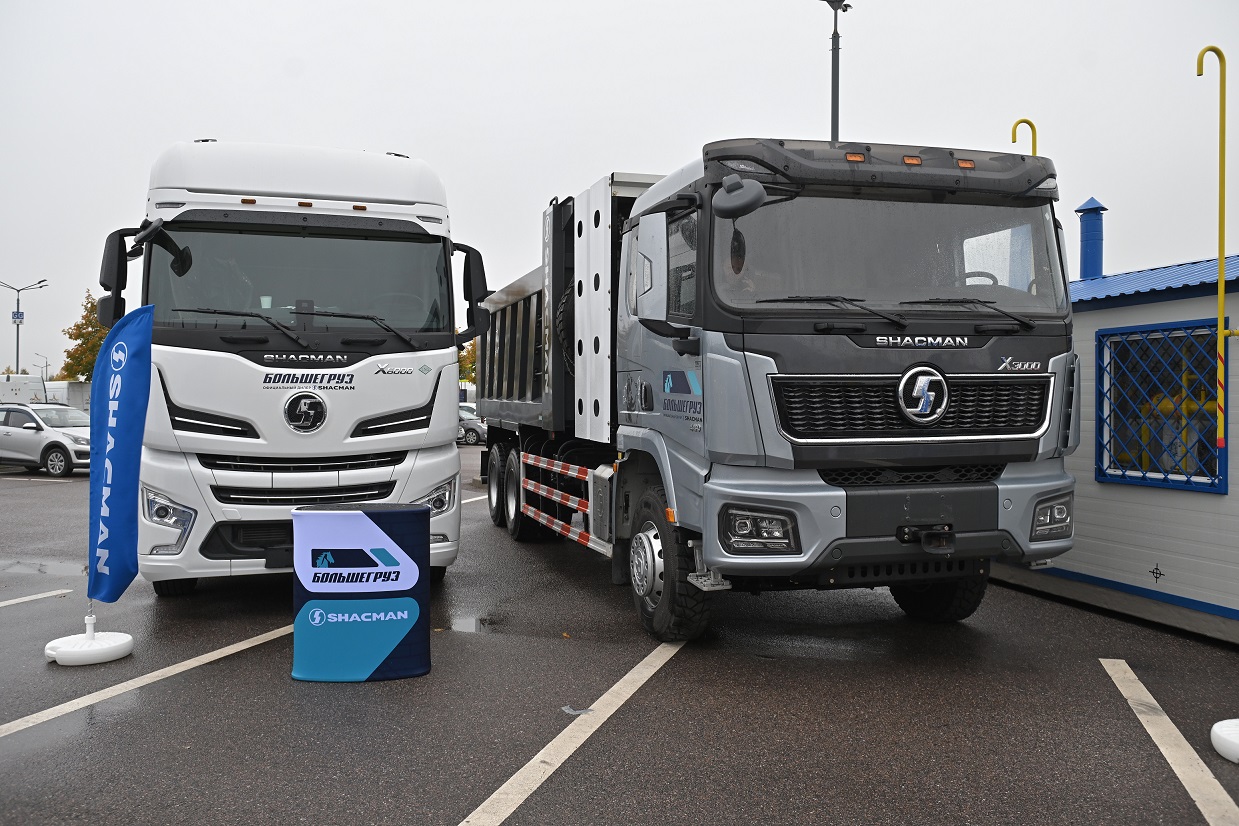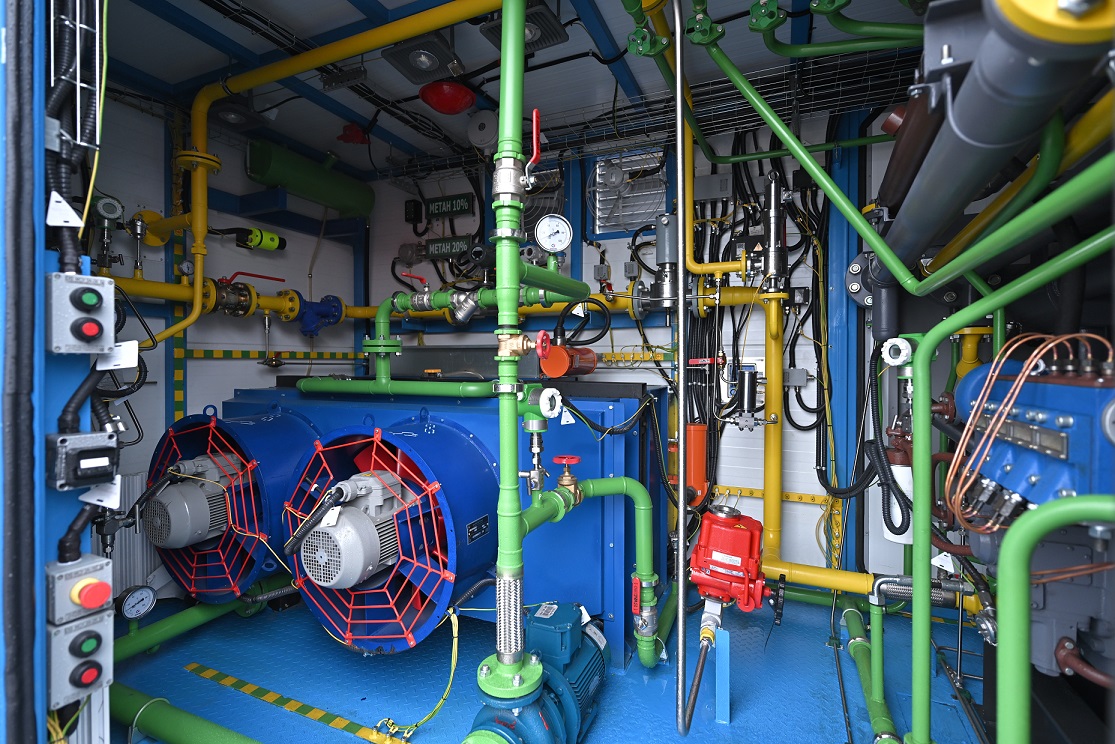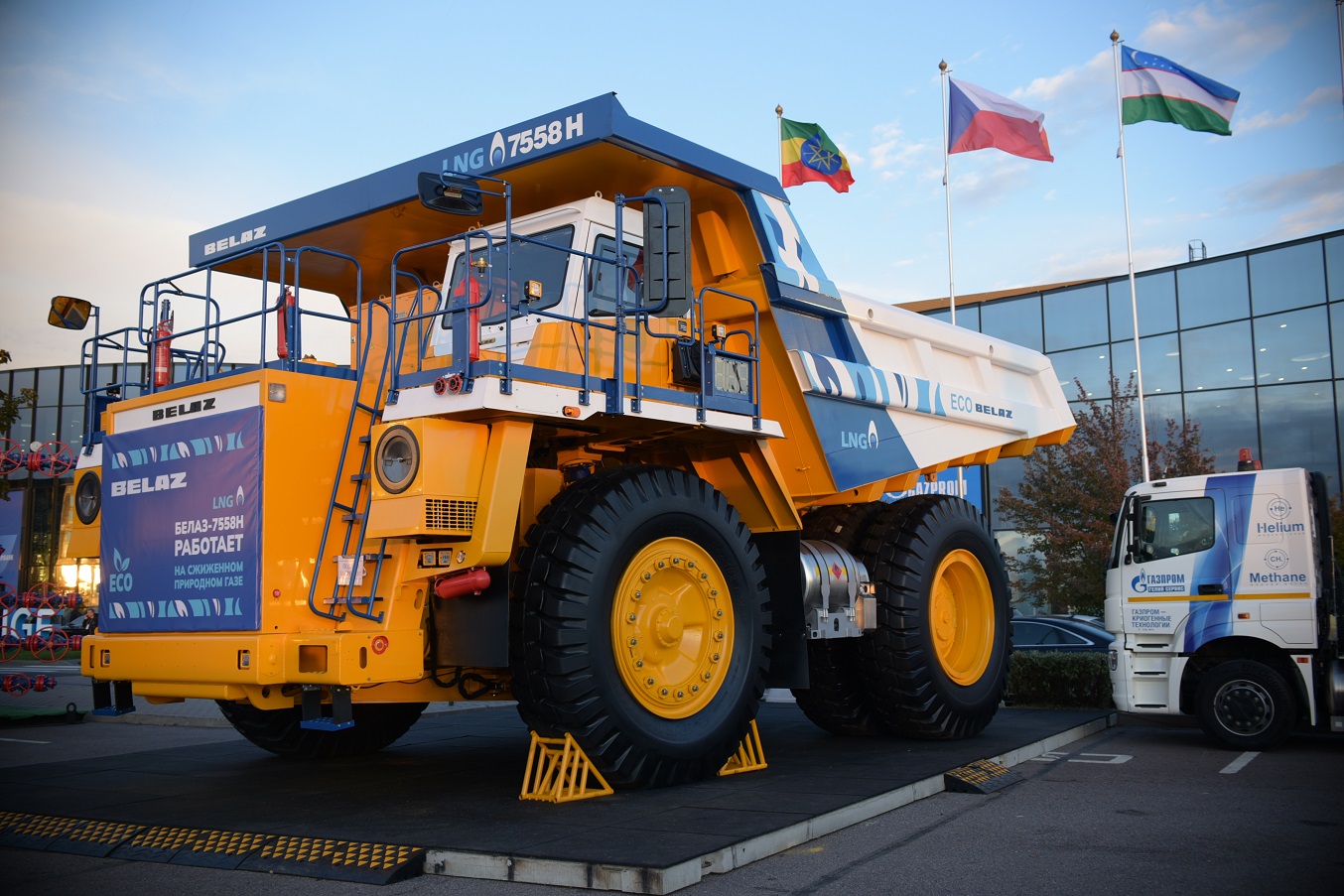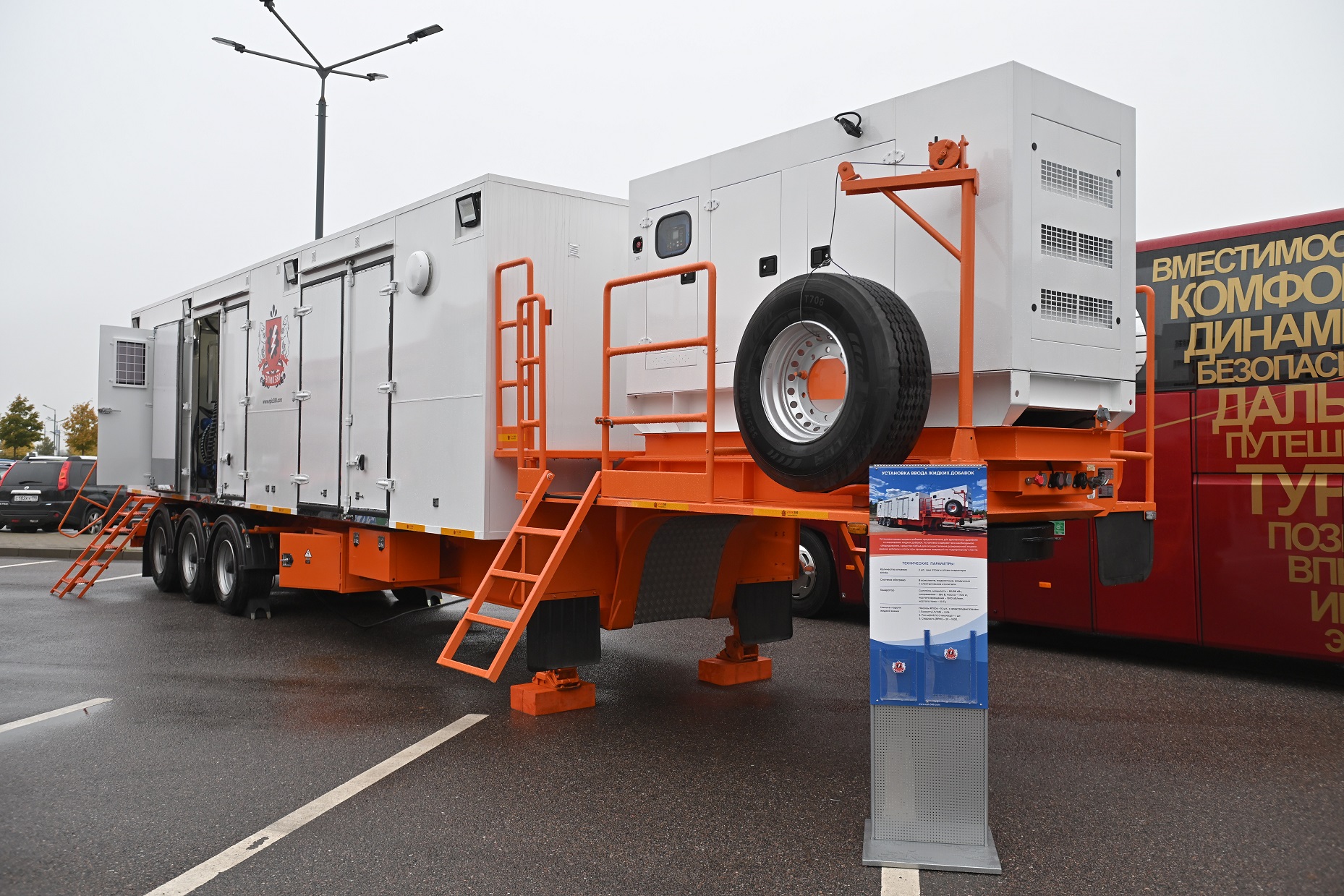
Portable gas tank trucks, Moskvich cars that run on biofuel, traditional dump trucks and tractors switched to gas – these are just some of the exhibits displayed in the outdoor exhibition arranged at ExpoForum Convention and Exhibition Centre during SPIGF 2024.
Commercial heavy trucks presented by AMT N. V. from Miass (ex Iveco AMT and Iveco UralAZ) included AMT N. V. 652900 dump truck designed to transport bulk dry cargoes and rocks; AMT N. V. 632911 road tractor with a crane manipulator (CM) designed for cargo transportation in trailers and semi trailers; CNG high sided track with a crane manipulator (CM). These vehicles are equipped to operate on compressed gas and are totally suitable for operation in the Russian climate.

Vitaly Kataev, Senior Structural Engineer of AMT N. V. mentioned that these exact models possess certain properties that can be referred to as unique. These are engines capable of 500 hp with a 2,280 Nm torque, and an average fueling interval of 300 to 500 km. AMT N. V. is one of the first Russian manufacturers who made dump trucks with such cubic capacity of the engine. The company produces 500 to 600 vehicles a year, but only a few dozen have enhanced properties and can run on gas. “Right now, we are starting to make our first batch for a major corporate partner – SpetsProfAlliance Company. At this stage, there are 8 machines, but we are going to deliver the same amount in the shortest term. In fact, we are willing to extend our list of supplies,” Vitaly Kataev summarized.
Together, SpetsProfAlliance and AMT N. V. are working on design, adaptation, pilot operation, and sales of vehicles that weigh 12 to 130 tons. By bringing out their machines with engines that run on clean and cost-saving motor fuels both companies contribute both to evolution of the automotive industry and protection of the environment.
Anton Elkin – a specialist from Bolshegruz, the official dealer of Shacman cargo vehicles, believes that making eco-friendly choices in the commercial transportation sector is the easiest way — “Let’s be honest. The support offered by the state promotes switching of vehicles to gas. Bus parks can and sometimes must do it to their buses. As for tractors and dump trucks, their diesel brethren are going to prevail in commercial transportation. Buying a vehicle is one thing, but maintaining it is a totally different one. Gas safety requirements are at a different level, and naturally not every company is eager to take the responsibility.”
Gas fuel is 2,5 to 3 times cheaper than diesel fuel, but gas vehicles cost like one third more, too. At the Gas Forum Exhibition, Bolshegruz presented their Shacman X6000 methane-operated tractor and a 20 cubic meters dump truck that runs on CNG (compressed gas). Their diesel equivalents cost 2.5 mln Rubles less, but gas tractors allow saving about 800 thousand Rubles a year on fuel. It means it takes nearly 3 years for the price difference to pay off, and only after this period benefits can be considered.
However, when buyers learn that the price difference is 3 mln Rubles, they start calculating. “For a big company, gas machines are more beneficial,” Anton Elkin confirmed, “but we are seeing this from our consumer POV, whereas business owners see it differently. Indeed, our country has got lots of gas. But what happens when a methane tractor drives outside of large cities? There hardly will be a gas fueling station in the middle of nowhere. The distance between gas stations is way too long. And you can’t bring gas in a can if somebody runs out of gas on the road. As soon as there will be infrastructure, there will be the demand.”

As regards to light vehicles, they are working hard to design automobiles that run on biofuels. RariTEK Holding showcased a Moskvich that all Russians know so well except that it uses gas engine fuel. The company is the official distributor of such hybrid cars. The petroleum version is manufactured by the automotive factory, following which RariTEK wraps it up as a biofuel. The fuel distance of the hybrid vehicle is 1 thousand kilometers, and 250 km are on natural gas alone. Serial production of Moskvich 3 was started in October 2024, and in November they are going to launch Moskvich 6. Hybrid Moskviches are pilot operated by the Russian Post, the Voluntary Association for Assistance to Army, Air Force and Navy, as well as other major corporate transport parks of Russia. Further on, they are going to offer these vehicles to regular buyers.

Stanislav Chechenev, Head of Moskvich Dealership Network Development at RariTEK Holding, agreed that lack of available gas filling stations can be deemed as a constraining factor. He believes that automotive gas filling compressor stations show good progress in St. Petersburg, Tatarstan, Bashkiria, and the Rostov Region and that’s why tomorrow is with them. “We’ve made some calculations to substantiate the economic attractiveness of hybrid vehicles for taxi companies,” Mr. Chechenev explained. “A hybrid vehicle costs about 10% more than its petroleum version, and for a methane-operated automobile the pay-off period is about half a year. It means the cost difference grades up in 6 to 7 months but where will you fill your cars?”
The fueling complexes presented at the exhibition provided an answer to this question. For instance, Gazprom Gas Engine Systems demonstrated their portable automotive gas filling truck 7000 as a universal solution of all the tasks related to emergency and independent gasification capable of natural gas (CNG) filling. It can transport up to 7 thousand cubic meters of CNG and its overall capacity is 110 cylinders, or 23.1 thousand liters. Tamerlan Aliev – Head of the Sales and Development Department at Gazprom Gas Engine Systems is positive that “the portable filling truck will provide a basis for Russia’s gas fueling infrastructure development. It will complement the existing automotive gas filling compressor stations as it will be able to deliver gas to distant consumers.”
Another automotive gas filling compressor station was exhibited in the outdoor display along with the portable gas compressor station, both of them brought by Krasnodar Compressor Factory, the top manufacturer of compressor equipment and compressor-powered machines.

Moreover, the visitors appreciated the carriage house produced by Unisteam Oilfield Steam Generators Plant and designed in collaboration with experts from Gazprom Transgaz Ufa. This habitable carriage is really comfortable thanks to its methane-operated equipment. It has got heating and lighting systems, a power generator, all kinds of household appliances, and a kitchen. The standard version has two working modes — heating by methane convectors and heating by an external electric energy source. Its CNG stock ensures living for at least 14 days.
Powered by Gazprom Transgaz Belarus, several companies presented their potential under the open sky at SPIGF 2024. There was a BelAZ 90-tons quarry truck that runs on LNG and possesses a Russian-made dump module for cryogenic tanks, a Galichanin 100-tons portable crane on Volat chassis by the Minsk Factory of Wheeled Tractors, and two collaborative projects by RariTEK – CNG-operated tractors produced by Belarus Minsk Tractor Factory and the world’s first LNG-operated grain harvester Polesye. The Belarussian section of the exhibition also included a MAZ X new gen dump truck, a MAZ long-range tourist bus, and a light automotive vehicle by Belgee with factory-installed gas equipment, which is the most popular one in Belarus today.

As part of the import substitution program, “Russia’s response to sanctions” was also reechoed by Epic 380 – a company from Nizhnevartovsk. They brought their unit that supplies liquid additions for hydrofracturing. Garyay Suyuchbakiev, a business promotion specialist at Epic 380, is sure that full-fledged fleets for hydrofracturing works can be produced in Russia: “Our company has been into manufacturing for 7 years, but only now we’ve got a chance to produce something that we used to buy abroad. We’ve already sold 10 units, and tenfold of pumping and mixing devices, and high pressure pumps. We can make everything locally.”
